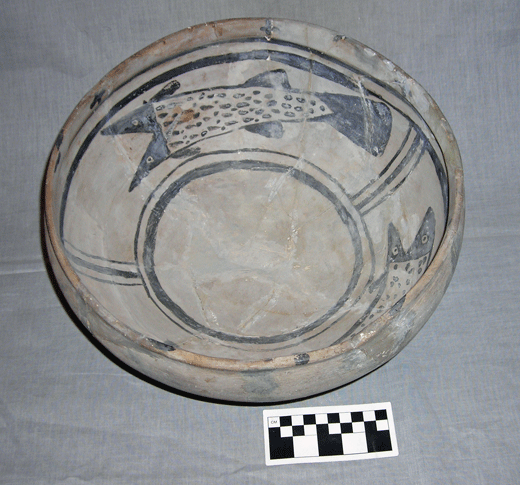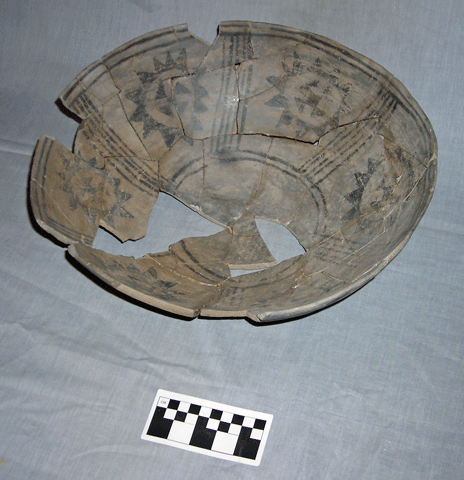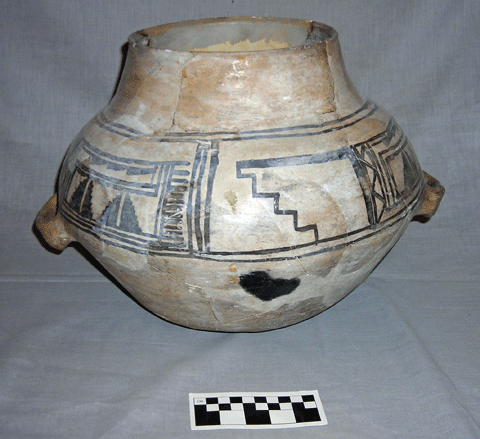
Rio Grande white wares
Encyclopedia

Pueblo I Era
The Pueblo I Era, from AD 750 to 900, was the first period in which Ancient Pueblo People began living in pueblo structures and realized an evolution in architecture, artistic expression, and water conservation...
, after adhering to a different and widespread regional ceramic tradition (the Cibola White Ware tradition) for generations, potters of the Rio Grande
Rio Grande
The Rio Grande is a river that flows from southwestern Colorado in the United States to the Gulf of Mexico. Along the way it forms part of the Mexico – United States border. Its length varies as its course changes...
region of New Mexico
New Mexico
New Mexico is a state located in the southwest and western regions of the United States. New Mexico is also usually considered one of the Mountain States. With a population density of 16 per square mile, New Mexico is the sixth-most sparsely inhabited U.S...
began developing distinctly local varieties of black-on-white pottery. This pottery involved the use of black mineral paint (mostly before AD 1200) or black vegetal paint (mostly after AD 1200) on a white, off-white, or light gray background. The black-on-white tradition finally died out about AD 1750.
Archaeologists divide the Rio Grande white wares into arbitrary types with much shorter life spans, primarily to help them date sites. Individual potsherds
Sherd
In archaeology, a sherd is commonly a historic or prehistoric fragment of pottery, although the term is occasionally used to refer to fragments of stone and glass vessels as well....
are assigned to types
Typology (archaeology)
In archaeology a typology is the result of the classification of things according to their characteristics. The products of the classification, i.e. the classes are also called types. Most archaeological typologies organize artifacts into types, but typologies of houses or roads belonging to a...
based on a combination of attributes including paste, temper, slip, paint composition, and design styles.
Overview and cautions
The Rio Grande white wares were made along the Rio Grande and adjacent valleys, from the TaosTaos, New Mexico
Taos is a town in Taos County in the north-central region of New Mexico, incorporated in 1934. As of the 2000 census, its population was 4,700. Other nearby communities include Ranchos de Taos, Cañon, Taos Canyon, Ranchitos, and El Prado. The town is close to Taos Pueblo, the Native American...
area south to San Marcial. The hallmark of Rio Grande white wares (as for the northern ancestral Puebloan peoples as a whole, from AD 500 to 1300) is the use of black painted designs on smoothed, often slipped, and sometimes polished white or light gray backgrounds. This combination of colors was achieved by firing pottery in a reducing (oxygen-starved) atmosphere. Despite these commonalities, the various Rio Grande traditions are only loosely related; the common thread is that each group of potters pursued variations on the regional black-on-white decorative tradition. When the various types are grouped, as is done here, it is primarily as a matter of classificatory convenience.
The earliest black-on-white pottery made in the region was part of the Cibola White Ware
Cibola White Ware
-History:The ware was produced roughly from the San Juan River south to the upper Gila River drainage, and from the White Mountains east to the Laguna Pueblo area —and probably east into the Rio Grande drainage...
tradition, which extended across the southeastern Colorado Plateau
Colorado Plateau
The Colorado Plateau, also called the Colorado Plateau Province, is a physiographic region of the Intermontane Plateaus, roughly centered on the Four Corners region of the southwestern United States. The province covers an area of 337,000 km2 within western Colorado, northwestern New Mexico,...
and into areas to the east and south. Thus, for example, Red Mesa Black-on-white of the Cibola tradition is common on Rio Grande region sites of the Pueblo II
Pueblo II Era
The Pueblo II Era, AD 900 to 1150, was the second pueblo period of the Ancient Pueblo People of the Four Corners region of the American southwest. During this period people lived in dwellings made of stone and mortar, enjoyed communal activities in kivas, built towers and water conversing dams,...
. In time, however, distinctly local pottery traditions arose. At first, as in the early Cibola White Ware tradition, the black paint used to paint pottery was mineral based. (For Arroyo Hondo Pueblo outside Santa Fe, Habicht-Mauche [1993:15–17] classifies the local mineral-painted white wares as the "Rio Grande Series" of Cibola White Ware rather than as a separate tradition.) After AD 1200, organic-based black paint (which reduces to amorphous graphite during firing) became the norm (Wendorf and Reed 1955). After 1750, the black-on-white pottery tradition had died out completely among Rio Grande Puebloan peoples. Some modern potters, especially those at Acoma Pueblo
Acoma Pueblo
Acoma Pueblo is a Native American pueblo approximately 60 miles west of Albuquerque, New Mexico in the United States. Three reservations make up Acoma Pueblo: Sky City , Acomita, and McCartys. The Acoma Pueblo tribe is a federally recognized tribal entity...
, have revived the tradition.
Archaeologists divide the Rio Grande white wares into a number of types
Typology (archaeology)
In archaeology a typology is the result of the classification of things according to their characteristics. The products of the classification, i.e. the classes are also called types. Most archaeological typologies organize artifacts into types, but typologies of houses or roads belonging to a...
. what follows is not an exhaustive typology (those can be found in the references provided). Rather, it is just extensive enough to allow non-specialists to understand the reasons for the existing named distinctions.
Named variants
One local variant on the Cibola tradition, San Marcial Black-on-white (AD 750–950) was used along the Rio Grande between CochitiCochiti, New Mexico
Cochiti is a census-designated place in Sandoval County, New Mexico, United States. It is part of the Albuquerque Metropolitan Statistical Area. The population was 528 at the 2010 census....
and Elephant Butte Reservoir
Elephant Butte Reservoir
Elephant Butte Reservoir is a reservoir on the Rio Grande in the U.S. state of New Mexico, north of Truth or Consequences. It is impounded by Elephant Butte Dam and is the largest reservoir in New Mexico...
. San Marcial was inspired by early vessels of the Cibola White Ware
Cibola White Ware
-History:The ware was produced roughly from the San Juan River south to the upper Gila River drainage, and from the White Mountains east to the Laguna Pueblo area —and probably east into the Rio Grande drainage...
tradition, and similarly had simple painted designs of the Pueblo I
Pecos Classification
The Pecos Classification is a division of all known Ancient Pueblo Peoples culture into chronological phases, based on changes in architecture, art, pottery, and cultural remains. The original classification dates back to consensus reached at a 1927 archæological conference held in Pecos, New...
tradition were executed in black mineral paint. San Marcial can be distinguished from the early Cibola types by its off-white paste containing sand and crushed rock (hornblende-latite) temper, and by thick vessel walls with polished but usually unslipped surfaces (Marshall and Walt 1984:37; Mera 1935:25; Wilson 2005:22). Later in the same general area, Socorro Black-on-white (AD 1050–1300) was characterized by carefully prepared designs using deep black, finely crazed mineral paint on a thin slip. The designs included combinations of solids and line hatching. Bowls were painted on the interiors only (Hawley 1950:36; Wilson 2005:25).

For pieces produced after 1200, when potters changed to a watery-looking organic black paint, the type name for this local tradition changes to Santa Fe Black-on-white (AD 1250–1350) (Hawley 1950:68–69; Wilson 2005:28). After 1300, the slip became whiter and the paint blacker, while the designs were carefully polished over. Such vessels, known as Wiyo Black-on-white (AD 1300–1400), can tentatively be ascribed to the prehistoric Tewa (Hawley 1950:70; Mera 1935; Wilson 2005:29).
Vessels of a third, post-1300 tradition is classified as Galisteo Black-on-white (AD 1300–1400). The interior slip is thick, white, often pearly, and distinctly “crackled.” Sherds of Galisteo Black-on-white are further distinguished from Santa Fe and Wiyo Black-on-white by having a darker core or “carbon streak” when viewed in cross-section. Angular crushed sherd temper is prominent. Bowl decorations are on the interiors only (Wilson 2005:34). Rim ticking (widely spaced spots of paint on rims) occurs, suggesting a possible link to earlier white wares of the Mesa Verde region. Hawley (1950:69) asserted that in the central and western portion of its range, Galisteo Black-on-white “is so similar to Mesa Verde Black on White that it can be distinguished only by detailed observations.” A somewhat cruder local variant with soft paste, Rowe Black-on-white, was made in the upper Santa Fe and upper Pecos drainages (Hawley 1950:69; Wilson 2005:35).

Jemez River
The Jemez River is a tributary of the Rio Grande in the U.S. state of New Mexico. The river is formed by the confluence of the East Fork Jemez River and San Antonio Creek, which drain a number of tributaries in the area of the Jemez Mountains and Santa Fe National Forest. The Jemez River is about ...
drainage. Vallecitos Black-on-white (AD 1250–1400) features bowl interiors with thorough polishing over dark black paint and a thick white slip. Rim ticking is common, again suggesting connections to the white ware tradition of the Mesa Verde region. Bowl exteriors were unpainted. The subsequent type in this series, Jemez Black-on-white (AD 1300–1750) includes painted designs on the exteriors (Hawley 1950:70–71; Mera 1935: 22–23; Wilson 2005:36–37).

Pajarito Plateau
The Pajarito Plateau is a volcanic plateau in north central New Mexico, United States. The plateau, part of the Jemez Mountains, is bounded on the west by the Valles Caldera and on the east by the White Rock Canyon of the Rio Grande...
area and northward turned to a soft, porous gray paste that resulted in thicker, distinctly gray vessels. Biscuit A (or Abiquiu Black-on-gray) bowls were slipped and decorated on the interiors only; they date from AD 1375 to 1450. Biscuit B (or Bandelier Black-on-gray) bowls are slipped and decorated on both surfaces; they date from AD 1400 to 1550 (Wilson 2005:31–32). Sankawi Black-on-cream (AD 1500–1650) features cream-colored surfaces, thinner walls and harder paste, the color of which has a reddish tinge. Afterwards, the design scheme changed to include red paint, resulting in today’s Tewa Polychrome tradition (Wilson 2005:38).
Even farther north are types restricted to the Taos area. Taos Black-on-white (AD 1150–1250) features Dogoszhi style (hachured) designs, albeit poorly executed, in black mineral paint on white polished slips (Mera 1935:6; Wilson 2005:24). Vadito Black-on-white (AD 1325–1600) features black organic paint on white-slipped backgrounds.

